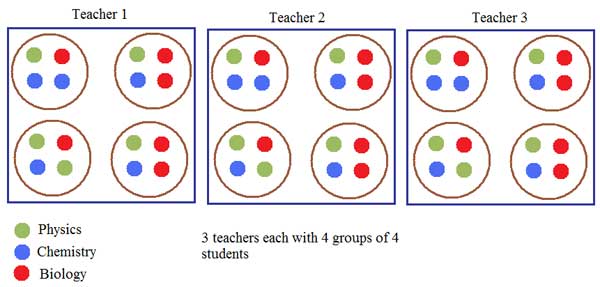Preparations
There are many ways to organise the Gp4 project however here I will focus on the way that we have done it at the school where I work. If we try a different model than I will add some more pages. The basic idea of this model is that each science teacher is responsible for about 16 students who are split into 4 groups of 4, These 16 students work on a common theme supervised and assessed by the member of staff, the project takes place on one day and ends with the 4 groups making a presentation to the class of 16.

School Calendar
The first step in planning the Gp4 project is to decide when it is going to be and get it in the school calendar. I like the "science day model" in other words setting aside a whole school day for the project. You will need to spend 10 hours on the project so depending on the length of your school day you might need 2 days, however if you start at 0800 and finish at 1800 with a working lunch you've got your 10 hours. Alternatively you could cut the day short and use a couple of hours in the evening for presentations or a "science fair" where the students present or display their results. Don't expect too much from a one day project. It might be a bit embarrassing when a student pronounces that "my conclusion is that my bedroom is colder when the window is open" in front of the schools chairman.
The science project is a good excuse to get outside so the weather is an important factor. You might also think of connecting the project with some other event like a trip to a fun fair or some other interesting place. We had a great day doing all sorts of experiments at a glacier, the science wasn't very memorable but the experience was. If the project is to be combined with a trip then it is important to make sure that there is still some groupwork to be carried out otherwise it won't be possible to do the assessment.
Don't leave the project too late in the year, certainly not after the IA sample has to be sent. We have tried many different times and have found that the best is either the end of the first year or the beginning of the second. Avoid the middle/end of the 3rd term, this is when students are doing their EE and university applications.
Gp4 Staff Meeting
A month or so before the project the science teachers need to meet to plan the day and decide on themes. You could involve students at this stage but you don't have to. Deciding on the theme can be made into part of the project but it can take up quite a big part of the 10 hours. One of the most successful days we have had was when each staff member chose a different theme, this meant that students could choose which theme they wanted to work with, being able to choose has a big effect on student motivation. If the school is involved in a particular project then it might be good to use the day to focus students attention on that. Finding ways to save energy or use waste is a theme that can have some practical outcomes.
Introductory meeting (1 hour)
If you are going to run several different themes then the students need to choose their theme and be put into groups before the day of the project. This can be done the day before. A simple way to do this is to make a short presentation about the themes and then get students to choose a theme on slips of paper or by standing next to a sign. The names in each group are then recorded and the students put into smaller groups.
Making Groups
The groups have to be a mix of "scientists" so if your students are choosing their themes you'll just have to hope that some from each science pick each option. it normally seems to work ok helped by students who do two science subjects but don't get too hung up about this, if you have to have two physics students and 1 chemist then so be it. The size of the group depends on the task that they are going to undertake however I would say that 5 is about the largest group you should consider, the larger the group the more difficult it is to get the group to work well together and 10 hours is not a long time. Assessing personal contributions is also more difficult with a larger group so you will make your life easier if you keep it small.
Making lists
After you have made the groups you will need to distribute the lists to the teachers responsible for each set of groups. these lists will be useful for attendance purposes and also can be used to record the students IA scores so its good to have a grid for the teacher responsible for the group to fill out with the final scores.
Informing people
Although this is a science project the students might well need to involve other members of the school staff such as the librarian, director of finances, kitchen staff, maintenance personnel etc. so its good to warn them that students might be asking them weird questions and to tell them that they aren't really wanting to build a 200m wind turbine in the middle of the campus it's just part of a project (although who knows).
